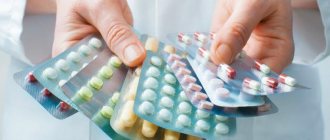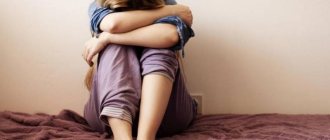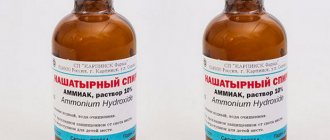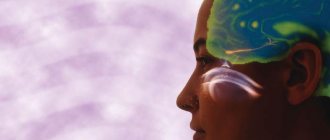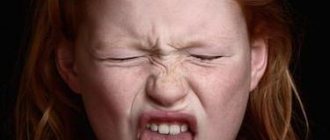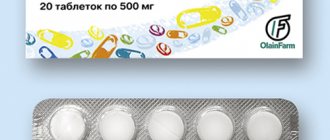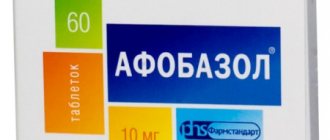Neuroleptics or antipsychotics are reluctantly and cautiously prescribed by most psychiatrists due to their severe side effects.
However, they are an important tool in eliminating productive symptoms, for example, in schizophrenia. To reduce the risk to the patient's health during the use of this group of psychotropic drugs, a new generation of antipsychotics or atypical antipsychotics, which have a milder effect on the human body, have been developed.
What kind of drugs are these?
Before chemically synthesized drugs were invented, drugs with plant components - belladonna, henbane, opiates, narcotic sleep, bromides or lithium salts - were used to treat mental illnesses.
Already in 1950, the first antipsychotic, chlorpromazine (aminazine), began to be actively used.
First-generation antipsychotics appeared 8 years after aminazine - the alkaloid reserpine, triftazine and haloperidol. They did not have the desired effect, causing neurological disorders and side effects (depression, apathy, etc.).
Until 1967, antipsychotics were called “ tranquilizers ” - they also had a pronounced sedative effect, but there is still a difference between them. The main difference between neuroleptics and tranquilizers is that the latter cannot influence psychotic reactions (hallucinations, delusions), providing only a sedative effect.
Neuroleptics relieve emotional stress, enhance the effect of painkillers, and have an antipsychotic, cognitive and psychosedative effect on the body.
They are prescribed to relieve symptoms of pathology such as:
- attacks of fear, aggression and agitation
- psychomotor agitation
- stuttering, vomiting and hiccups
- sleep disorder
- hallucinations, speech delirium
- manic states
The mechanism of action of antipsychotics is to suppress nerve impulses in those systems (limbic, mesocortical) of the human brain that are responsible for the production of dopamine and serotonin.
Mechanism of action of antipsychotics
They have a short half-life and are well absorbed by any route of administration, but the period of influence on the nervous system is short - therefore they are prescribed in combination to stimulate each other.
Neuroleptics, penetrating the BBB between the central nervous and circulatory systems, accumulate in the liver, where complete breakdown of the drugs occurs, and are then excreted through the intestines and genitourinary system. The half-life of antipsychotics ranges from 18 to 40 hours, and even 70 hours in the case of Haloperidol.
For serious illnesses, long-acting antipsychotics are prescribed, which are administered intravenously and have a therapeutic effect for about 3 weeks.
Some representatives of the group
Risperidone is probably the most prominent representative of the 2nd generation antipsychotics. Being a powerful dopamine receptor blocker, it exhibits a strong, effective antipsychotic effect. But, along with this, the list of its side effects is quite wide. Compared to other “atypists,” it causes depression, increased prolactin and extrapyramidal disorders to a greater extent, provokes nausea and vomiting, weight gain, drowsiness and other undesirable reactions. But no one writes him off, since he most effectively fights psychotic agitation.
Quetiapine . One of the safest atypical antipsychotics. Shows a pronounced anti-anxiety effect and normalizes mood. It has a weak effect on serotonin and dopamine receptors, and has a greater effect on adrenergic receptors. Used for schizophrenia and bipolar disorder.
Fluphenazine . The drug is for injection use. It has a moderate effect on the noradrenergic system, and a pronounced effect on the dopamine system. Eliminates irritability and has a psychoactivating effect. Used for hallucinations and to treat neuroses.
The drug is administered intramuscularly in a dose of 0.25 or 0.5 ml with further consideration of the administration regimen. It can enhance the effects of other psychotropic drugs and alcohol, so their simultaneous use is undesirable. When used in parallel with narcotic analgesics, it causes depression of the central nervous system and respiration.
Clopixol was developed more than 20 years ago. It is actively used abroad, but in Russia it was introduced into practice relatively recently. The drug acts on 3 types of receptors: serotonin, dopamine and adrenergic. Available in two forms: injections and tablets.
Injectable forms are Acufase and Depo.
Clopixol-Acupaz is used for acute psychosis, exacerbations of its chronic forms, as well as for mania. It eliminates the nuclear symptoms of schizophrenia: hallucinations, mania, disturbances in mental activity, relieves anxiety, aggressiveness, and reduces manifestations of hostility.
One injection of the drug is enough to relieve acute symptoms. The effect lasts up to three days. After this, they will probably appear again, so it is advisable to prescribe Clopixol in the form of depot or tablets.
Clopixol-Depot provides a prolonged sedative effect. The maximum effect is achieved after the first week after administration of the drug. A single injection of 1 ml of Clopixol-Depot for two weeks or 2 ml for four weeks replaces the daily intake of tablets of the same name for 14 days.
Side effects
The greater the dosage and course of antipsychotic therapy, the higher the likelihood of unpleasant consequences for the body.
Side effects of antipsychotics are also associated with age, health status and interactions with other drugs.
They can cause:
- disruption of the endocrine system (prolacthymenia, amenorrhea, erectile dysfunction)
- disorders of the central nervous system (akatasia, muscular dystonia, parkinsonism)
- neuroleptic syndrome (inhibition of actions, slurred speech, oculogyric crisis, in which the head is thrown back and the eyes roll back)
- loss of appetite, drowsiness, weight loss or gain
In 10% of cases, problems with the gastrointestinal tract, cardiovascular and genitourinary systems occur, and akathisia caused by antipsychotics occurs in 26%. But the main thing that makes them dangerous for humans is the “ withdrawal syndrome ” caused by a sudden cessation of taking antipsychotics. The patient becomes so accustomed to the daily dose of medication that, without receiving it again, he falls into a state of depression or constant discomfort. “Withdrawal syndrome” has several varieties and can lead to psychosis and tardive dyskinesia.
Some patients, unable to see improvements after treatment, the effect of which does not occur immediately, try to cope with depression with the help of alcohol. But combining antipsychotics and alcohol is strictly prohibited, since when interacting they can cause poisoning and even a stroke.
Dosage regimens
The prescription of atypical antipsychotics must be strictly justified, and their administration requires strict adherence to the regimen. They are prescribed in several ways.
The most reliable and proven is a gradual increase in dose .
In contrast to the previous method, the fast : the dose is increased to an acceptable one within a few days, and all subsequent treatment is maintained at this level.
The zigzag method involves periodically changing high and low doses throughout the entire therapy.
The shock method involves administering the drug in the maximum dosage several times a week. Thus, the body experiences a kind of chemical shock, and psychosis recedes under its influence.
Combination therapy is also used , in which several groups of antipsychotics are used. These can be exclusively atypical antipsychotics or a combination of both generations.
New generation neuroleptics without side effects
Thanks to the active development of researchers, the list of antipsychotics is annually replenished with a new generation of antipsychotics, which can now be differentiated according to the duration and severity of the clinical effect, mechanism of action and chemical structure.
Modern drugs have less effect on the brain, do not cause addiction or side effects, but are more likely to be antidepressants that eliminate symptoms rather than a means of treatment.
These include: Abilify, Quetiapine, Clozasten, Levomepromazine, Triftazine, Fluphenazine, Fluanxol.
Advantages:
- There are no disturbances in psychomotor reactions
- safe for treating children
- the risk of developing pathologies is reduced
- easy tolerability
- One dose of the drug is enough to achieve a positive result
- help with skin diseases (recent studies have shown that treating dry skin with antipsychotics produces positive results in older people whose diseases are associated with neuralgia)
Use in combination with neuroblockers
There are various indications for taking medications in combination with neuroblockers. This treatment helps with attention deficit disorder accompanied by hyperactivity. This disease is characterized by symptoms such as excessive impulsiveness and absent-mindedness.
Medications help relieve post-traumatic stress disorder.
Complex medication use is also indicated for anorexia and bulimia. They are also prescribed for generalized anxiety disorder, accompanied by depression and unreasonable fears. The main manifestation of this pathology is persistent anxiety, not associated with any stressful situations.
List of drugs without prescriptions
There are a number of antipsychotic medications that can be purchased without a prescription.
They are considered safe for the patient and help in relieving stress, muscle spasms, depression and mental disorders.
- Ariprizole (treatment of bipolar disorder type 1) - 2500 RUR/30 tablets.
- Afobazole (treatment of schizophrenia) - 700 rub./60 tablets.
- Quetiapine (treatment of acute and chronic psychoses) - 700 rub./60 tablets.
- Olanzapine (treatment of psychotic and affective disorders) - 300 rub./30 tablets.
- Risperidone (treatment of schizophrenia, Alzheimer's disease, dementia) - 160 rub./20 tablets.
- Tizercin (treatment of mental retardation, epilepsy, enhancing the effect of analgesics) - 231 rub. /10 amp.
Most people are misled about the dangers of antipsychotics, but pharmacology does not stand still, and old-generation antipsychotics are almost no longer used in medicine.
Modern drugs have virtually no side effects, and brain activity is restored within three days after the drug is removed from the body.
Many patients wonder how to restore the brain after antipsychotics , and the answer will depend on the degree of damage to the body. Traditionally, doctors prescribe a balanced vitamin and mineral complex, as well as antioxidants and immunomodulators to cleanse the blood.
For intoxication with antipsychotics, neurasthenia and to relieve “withdrawal syndrome”, Cytofavin and Mexidol are prescribed.
Aminazine and Levopromazine
A relatively safe drug belongs to phenothiazine derivatives. The drug helps eliminate psychomotor agitation. Aminazine reduces the severity of symptoms such as delusions and hallucinations.
Aminazine enhances the effect of tranquilizers and antidepressants.
The drug is effective for obsessive-compulsive disorder. Aminazine is used for alcoholic psychosis. One of the indications for the use of the drug is persistent sleep disturbance.
Levopromazine is characterized by sedative, hypotensive and antidepressant properties. The drug, which does not have a negative effect on brain activity, is prescribed for dementia. Levopromazine is also used for mental and motor disorders.
Teraligen
According to many patients, Teraligen is an antipsychotic, the best for neuroses. It is also used for neurosis-like conditions.
The active component of the drug is alimemazine tartrate. The tablets have a rather complex composition. The auxiliary components of Teraligen include: colloidal silicon dioxide, lactose, talc, wheat starch. The medicine has antispasmodic, hypnotic, and antipsychotic effects. The tablets help with sleep problems, somatic diseases, and depression. An antipsychotic that eliminates psychoasthenic symptoms is the safest drug for psychopathy.
Possible complications
If the recommended dosage is followed, undesirable consequences occur extremely rarely. In this case, the risk of side effects is minimal. The following factors influence the tolerability of antipsychotics:
- presence of chronic diseases;
- age of the patient taking antipsychotics;
- duration of the course;
- use in combination with new generation antipsychotics and other drugs.
One of the most common side effects is weight gain. Loss of appetite may also occur. In the first days of taking antipsychotics, lethargy and apathy are often observed. Muscle spasms may also occur, which are eliminated by reducing the prescribed dose of the antipsychotic.
Contraindications
Both atypical and typical antipsychotics have a common list of contraindications:
- individual intolerance to drugs;
- the presence of angle-closure glaucoma, prostate adenoma, porphyria, parkinsonism, pheochromocytoma;
- a person's history of allergic reactions to neuroleptics;
- disorders of the liver and kidneys;
- pregnancy and breastfeeding;
- diseases of the cardiovascular system;
- acute febrile conditions;
- coma.
Sonapax
When using Sonapax, it is not recommended to drink alcohol or alcohol tinctures. The active component of the antipsychotic is thioridazine. It is a phenothiazine derivative.
Sonapax has a strong effect on the peripheral and central nervous system. The drug has tranquilizing and antipruritic properties. It helps eliminate aggression.
The main indication for the use of Sonapax is complex behavioral disorders that disrupt the patient’s normal life. The product improves cognitive functions. It is used for sleep disorders and various phobias.
Classification of antipsychotics
It was already mentioned above that antipsychotics are divided into typical and atypical.
Typical antipsychotics include:
- Sedative antipsychotics (having an inhibitory effect after use): promazine, levomepromazine, chlorpromazine, alimemazine, chlorprothixene, periciazine and others.
- Incisive antipsychotics (have a powerful global antipsychotic effect): fluphenazine, trifluoperazine, thioproperazine, pipothiazine, zuclopenthixol, and haloperidol.
- Disinhibiting (have an activating, disinhibiting effect): carbidine, sulpiride and others.
Atypical antipsychotics include aripiprazole, sertindole, ziprasidone, amisulpride, quetiapine, risperidone, olanzapine and clozapine.
There is another classification of antipsychotics, according to which they distinguish:
- Phenothiazines, as well as other tricyclic derivatives. Among them there are the following types: ● neuroleptics with a simple aliphatic bond (levomepromazine, alimemazine, promazine, chlorpromazine), powerfully block acetylcholine receptors and adrenergic receptors, have a pronounced sedative effect and can cause extrapyramidal disorders; ● neuroleptics with a piperidine core (thioridazine, pipothiazine, periciazine), which have a moderate antipsychotic effect and mild neidocrine and extrapyramidal side effects; ● neuroleptics with a piperazine core (fluphenazine, prochlorperazine, perphenazine, thioproperazine, frenolone, trifluoperazine) are capable of blocking dopamine receptors and also have a weak effect on acetylcholine and adrenergic receptors.
- All thioxanthene derivatives (chlorprothixene, flupentixol, zuclopenthixol), the action of which is similar to the action of phenothiazines.
- Substituted benzamides (tiapride, sultopride, sulpiride, amisulpride), the action of which is also similar to phenothiazine antipsychotics.
- All butyrophenone derivatives (trifluperidol, droperidol, haloperiodol, benperidol).
- Dibenzodiazapine and its derivatives (olanzapine, clozapine, quetiapine).
- Benzisoxazole and its derivatives (risperidone).
- Benzisothiazolylpiperazine and its derivatives (ziprasidone).
- Indole and its derivatives (sertindole, dicarbine).
- Piperazinylquinolinone (aripiprazole).
Of all the above, we can distinguish available antipsychotics - drugs sold without prescriptions in pharmacies, and a group of antipsychotics that are sold strictly as prescribed by a doctor.
Who are nootropics indicated for?
Today these are drugs that are common in therapeutic and pediatric practice and are indicated for patients for:
- stimulation of brain neurotransmitters during degenerative, post-traumatic changes;
- improving the psychological state, correcting memory, stimulating cognitive abilities in the treatment of alcoholics and drug addicts;
- facilitating the adaptation process in a stressful situation;
- stimulating patients with lethargy, apathy;
- antidepressant therapy.
It should be understood that nootropics are not drugs that can radically improve an individual’s cognitive abilities. However, they help improve cellular nutrition of the brain, which stimulates memory and mental activity in humans.
Normotimics
Normotimics control affective manifestations and provide a preventive effect in bipolar disorders. The drugs stabilize the mood of autistic adolescents and reduce behavioral disorders.
During treatment, it is necessary to monitor the content of lithium salts in the blood. Among the adverse reactions to the use of lithium mood stabilizers, experts note slight tremor and an increase in the volume of urine excreted, and hypothyroidism.
Carbazepine and its derivatives, Lamotrigine and valproate can also be used in the treatment of autism in children. When using mood stabilizers, constant medical supervision is required. In fact, the drugs are stabilizers of the psycho-emotional state, helping to normalize the mood of mental patients.
Haloperidol
The active substance of the drug is a butyrophenone derivative with a characteristic antipsychotic effect and moderate sedative properties. Haloperidol helps with persistent vomiting. The drug eliminates stuttering and psychoses of various natures. Haloperidol helps with acute mental disorders. The drug eliminates confusion. Haloperidol is also effective against hallucinations.
Fluphenazine
Fluphenazine belongs to a broad-spectrum drug with a large list of indications. The drug is prepared in the form of an injection suspension. Fluphenazine is used in the treatment of schizophrenia.
The drug helps with restlessness and increased nervous excitability.
The antipsychotic, which causes side effects relatively rarely, helps improve mental activity.
Fluphenazine is not used in combination with antispasmodics. The active component of the drug is fluphenazine decanoate.
Structural changes in the brain with long-term use
According to placebo-controlled studies of macaques that were given olanzapine or haloperidol at normal dosages for two years, brain volume and weight from taking antipsychotics decreased by an average of 8-11%. This is due to a decrease in the volume of white and gray matter. Recovery from neuroleptics is impossible.
After the publication of the results, the researchers were accused that the effects of antipsychotic drugs were not tested on animals before being introduced into the pharmaceutical market, and that they pose a danger to humans.
One of the researchers, Nancy Andreasen, is confident that a decrease in the volume of gray matter and the use of antipsychotics in general negatively affects the human body and leads to atrophy of the prefrontal cortex. On the other hand, she noted that antipsychotics are an important medicine that can cure many ailments, but they need to be taken only in very small quantities.
In 2010, researchers J. Leo and J. Moncrieff published a review of studies based on magnetic resonance imaging of the brain. The study was carried out to compare brain changes in patients taking antipsychotic drugs and patients not taking them.
In 14 of 26 cases (in patients taking antipsychotics), a decrease in brain volume, gray matter and white matter was observed.
Of the 21 cases (in patients who did not take antipsychotics, or who took them, but in small doses), no changes were found in any of them.
In 2011, the same researcher Nancy Andreasen published the results of a study in which she found changes in brain volume in 211 patients who had been taking antipsychotics for quite a long time (more than 7 years). Moreover, the higher the dose of medication, the more significantly the brain volume decreased.
What other antipsychotics are on the market?
There are not many drugs in this group on the pharmacological market that can be purchased in pharmacies without a prescription. The first generation of products are not sold commercially and are only available in state pharmacies.
In children from the age of 3 years, the drug Clozapine is prescribed - a strong antipsychotic with a number of serious side effects.
Experts often recommend the antipsychotic Tizercin (Levomepromazine) as a mild sedative. It has a positive effect on the autonomic nervous system, reducing the frequency of mood swings, depressive states, and asthenic manifestations. Also the drug:
- blocks unreasonable fear;
- eliminates a constant state of anxiety;
- helps with neurotic disorders.
Another remedy is Quetiapine (680 rubles) with the active substance of the same name. Its big advantage is the lack of impact on the body's hormonal system. Even with long-term use, prolactin levels remain at the same level. Side effects are also rare - headaches, dizziness, diarrhea or constipation, and increased levels of liver enzymes (reversible) prevail among them. The drug is widely used against various types of depressive disorders.
Other known antipsychotics:
- Invega;
- Eglonyl;
- Aminazine;
- Leponex;
- Melleril.
The course of treatment can last for months, but the longer it is, the higher the risk of developing withdrawal syndrome. You need to stop taking medications in stages, gradually reducing the dose.
Restoring the body after taking pills
As you know, it is quite difficult to “get off” antipsychotics after many years of using the pills. The drugs inhibit the production of dopamine. After stopping taking antipsychotics, emotions often become dulled.
In most cases, it is possible to restore the normal state of the emotional sphere with the help of special medications. The production of dopamine is also activated when walking in the fresh air. Regular physical exercise also contributes to the patient’s recovery.
Some of the most effective drugs for improving dopamine production include:
- Tyrosine;
- Dopamine.
In order not to leave the path of recovery and not fall into depression again, you need to watch your diet. Foods rich in tyrosine are beneficial. The diet should include seafood, green tea, bananas, and chicken eggs.
Ginkgo biloba after taking antipsychotics
Taking care of your health too late can lead to unwanted complications. Therefore, after completing the course of taking antipsychotics, it is recommended to take ginkgo biloba. The medicinal plant helps improve peripheral and cerebral circulation.
In this simple way you can achieve changes such as:
- improved sleep;
- restoration of normal blood circulation in the lower extremities;
- memory improvement.
Ginkgo biloba is contraindicated in case of hypersensitivity to its components. A plant with this name should not be used for severe diseases of the digestive tract. The use of ginkgo biloba is not recommended for those with reduced blood clotting.
Literature
- Mufazalova N.A. NEUROLEPTICS // International Journal of Experimental Education. – 2020.
- Drobizhev M.Yu., Ovchinnikov A.A. Antipsychotics: changing old generations to a new classification? //Social and clinical psychiatry. – 2010.
- Yastrebov D.V., Avedisova A.S. Some aspects of therapy with atypical antipsychotic drugs using the example of olanzapine. Modern therapy in psychiatry and neurology 2012.
- Symbyax Prescribing Information. Eli Lilly and Company, 2010. https://pi.lilly.com/us/symbyax–pi.pd
- Tandon R., Nasrallah H., Keshavan MS Schizophrenia, “just the facts.” 5. Treatment and prevention. Past, present and future // Schizophr. Res. 2010.
Lyudmila Zhavoronkova
Higher medical education. 30 years of working experience in practical medicine. More about the author
All articles by the author
Feedback from parents about drug treatment
Reviews from parents who have personally encountered a similar disease in their child will help you understand the effectiveness and relevance of prescribing a particular medication.
Rispolept for autism in children has earned a lot of positive reviews, although the drug is not suitable for everyone:
- The psychiatrist prescribed Rispolept oral solution for my daughter at the age of 20 months. After only a week of treatment, my daughter began to fall asleep normally, without hysterics, and began to repeat words. We have been taking Rispolept for more than 2 years, intermittently, and have not noticed any side effects;
- We have a mild form of autism, so we periodically have to undergo a course of medication. We were prescribed Rispolept, given morning and evening, which soon led to enuresis. Then complications appeared on the liver. In general, I had to refuse the appointment so as not to kill the child.
Review of Cortexin for autism: “The medicine is one of the few from which real benefits are noticeable. My son is 5.5 years old and was diagnosed with autism a year and a half ago. The psychoneurologist prescribed Cortexin. Already on the 10th day there were improvements - the son became interested in drawing when the older child was drawing. Soon he learned to count to 10 again, and after the second course of Cortexin he began to talk again. In general, the results are obvious.”
And the mother of one of the little patients left this review about the drug Encephabol: “We were prescribed the nootropic Encephabol when a lag in speech development began to appear. We took the medicine for 2 weeks, after which an allergic rash appeared, but changes in the treatment also began, irritability disappeared, sleep disturbances also disappeared, the son began to make distinct sounds that had not previously been noted.”
Review of Cogitum for autism: “Among many other medications, we were prescribed Cogitum for a 20-day course - 10 days of taking a capsule in the morning, then a 10-day break, then again 10 days of taking a capsule per day. After the course, improvements began to appear: my understanding of speech increased noticeably, I began to repeat words, and I became more diligent. That is, progress is obvious.”
Feedback on the use of Pantogam for autism: “The neurologist prescribed Pantogam to my son in combination with other drugs. I’ve been taking the pills for 2 months now and we’ve seen clear improvements such as speech progress, perseverance and memory improvements.”
Glycine is often prescribed for autism. Quote from a review of this drug: “Glycine has a beneficial effect on a child’s sleep, improves brain activity, and eliminates the pronounced hyperactivity of autistic children.”
It is unacceptable to independently give a child nootropic, neuroleptic and other medications in an attempt to improve learning ability, calm the child or normalize his sleep. These drugs can be dangerous if taken incorrectly and inadequately.
Any medications for autism are used only as prescribed by a doctor. In the treatment of this disease, serious drugs are used, the independent use of which is fraught with dangerous complications.
